Extracurricular Training Part 1 – The Antagonists
In the literary world, the “antagonists” represent the bad guy – the person, place, or thing that causes conflict and opposition to the “protagonist,” or good guy. Lord Voldemort, Sauron, and even Satan are classic examples of antagonists. It’s no wonder that we as climbers tend to steer clear of training our antagonist muscles…But joking aside, however, this type of training should be a very important component to EVERY climber’s training regimen, from beginners to the elite. Here’s why.
Just like their literary counterparts, antagonist muscles in climbing are the muscles that act in opposition to the main muscles used during climbing movement (aka agonists). Imagine the typical movements a climber uses to get up the wall – they can usually be summed up by the word “PULL.” Pulling up, pulling in, pulling towards the rock. The antagonist muscles to the PULL muscles can be summed up by the word “PUSH.” Pushing down, pushing out, pushing away from the rock. As climbers, we naturally tend to have uber strong pull muscles (anyone ever seen Chris Sharma’s back?), but disproportionately weak little push muscles (and puny leg muscles too, but that’s a whole different post…)
Vanity aside, there are several really good reasons why training your PUSH muscles is not only beneficial, but essential for climbers. The PULL/PUSH muscles work together in a very ying-yang type way. When both are strong, they complement each other, and are in perfect balance. If one overpowers the other, an imbalance occurs, leaving the body vulnerable to injuries such as rotator cuff tears, tendonitis and overall joint instability.
I learned my lesson about antagonist muscles the hard way in 2008 when my PULL training minus PUSH training landed me with a torn rotator cuff and 3 months off. To be honest I knew better but just got lazy. Ever since then I’ve been religious about training antagonist muscles at least once or twice a week, depending on the time of year. This past year as I’ve started to climb a lot harder, I’ve added in a few more exercises to my regimen, figuring that the extra pull-power I’m gaining could benefit from some counter-balance. And of course now that I’m on the disabled list for a few weeks with my ball and chain ankle boot, I’m hitting the weight room with a new fervor.
However, a no-frills, basic antagonist routine doesn’t have to take hours per week away from your regular climb time. A quick 20 minute circuit of a few simple exercises twice per week should put you well on your way to beefing up your PUSH muscles. Perform these exercises as a cool-down after a climbing workout, or on rest days from climbing. Start with 2-3 basic sets, and add more sets and reps as you get stronger. Also listed are variations that you can do in addition to or in place of the basic exercises to change the difficulty and add variety. Let me emphasize that some of these exercises can wreak havoc on your shoulders if you’re not careful, so if you currently are nursing a shoulder injury, please consult a doctor or a PT for guidance.
PUSH-UPS: Quite possibly one of the world’s perfect exercises – works all of the PUSH muscles, with some core thrown in, and no equipment needed! Do them on your knees if you have to compromise form to get more than a handful. Do them on a BOSU ball if you want to feel your rotator cuff work too. And if you really want the full-value version, try some on a pair of gymnast rings. But regardless of what poison you pick, do them. They’re mucho importante.
Additions/Variations: Bench or Dumbbell Press (Flat Bench or Incline), Dumbbell Flyes (Flat Bench, Incline, or Cable), Gymnast Ring Flyes
DIPS: These are key for strengthening the triceps (and also might help out your mantle skills…). If these are too hard to do outright, there are several options – have a partner support some of your weight, do “negatives” (use a box to cheat your way to the “up” position each time, and concentrate on slow, perfect form on the way down), or you can do them on a bench.
Additions/Variations: Triceps Extensions (aka “Kickbacks”), Triceps Pushdowns
OVERHEAD SHOULDER PRESS: You don’t need a ton of weight for these to be effective – remember the key word is balance, not Schwarzenegger physique! If you’ve got an impingement issue with your shoulder, proceed with caution – keep the range of motion small and don’t take these all the way up to locked out arms.
Additions/Variations: Lateral/Front Raises, Military Press, Arnold Press
REVERSE WRIST CURLS: Think about how often your forearm flexors (palm side of your hand) get pumped…now picture when the last time your forearm extensors (back of your hand side) got a good workout. If you can’t remember the last time, you’re probably working on a significant imbalance that eventually will lead to elbow problems. Reverse Wrist Curls are a quick and easy fix.
Additions/Alternatives: Rice Bucket Workout (more on that later), Pronator Twists
As with anything else, listen to your body. If you feel funky twinges, tweaks, or anything other than that deep, “feel-good-hurt” burn, stop and reassess your form, adjust your weight, or allow your body more time to recover in between sessions. Remember, as much as it sucks being injured, no body wants to say it happened off the rock and in the weight room!
Ok now its time to fess up – who here has been slacking off on their PUSH muscles? For those of you that are diligent, did you learn the hard way or are you one of those proactive people with better than average common sense?
(Click here for Part 2 of this posts, which discusses ways to stabilize the shoulders…)

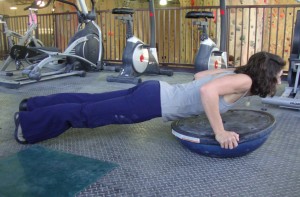
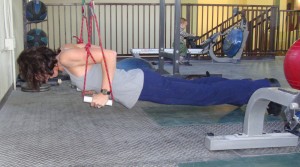
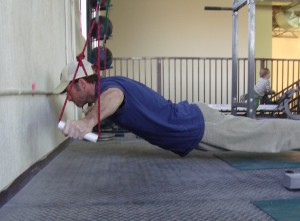
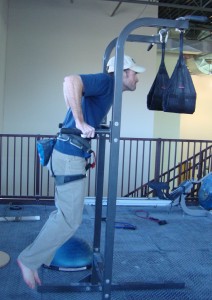
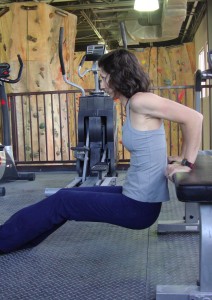
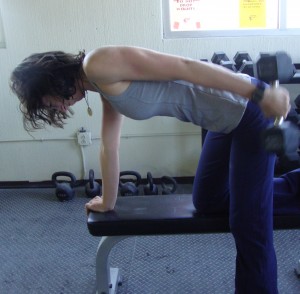
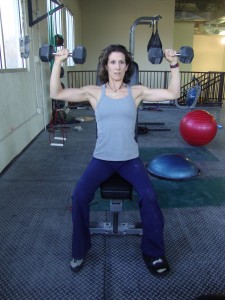
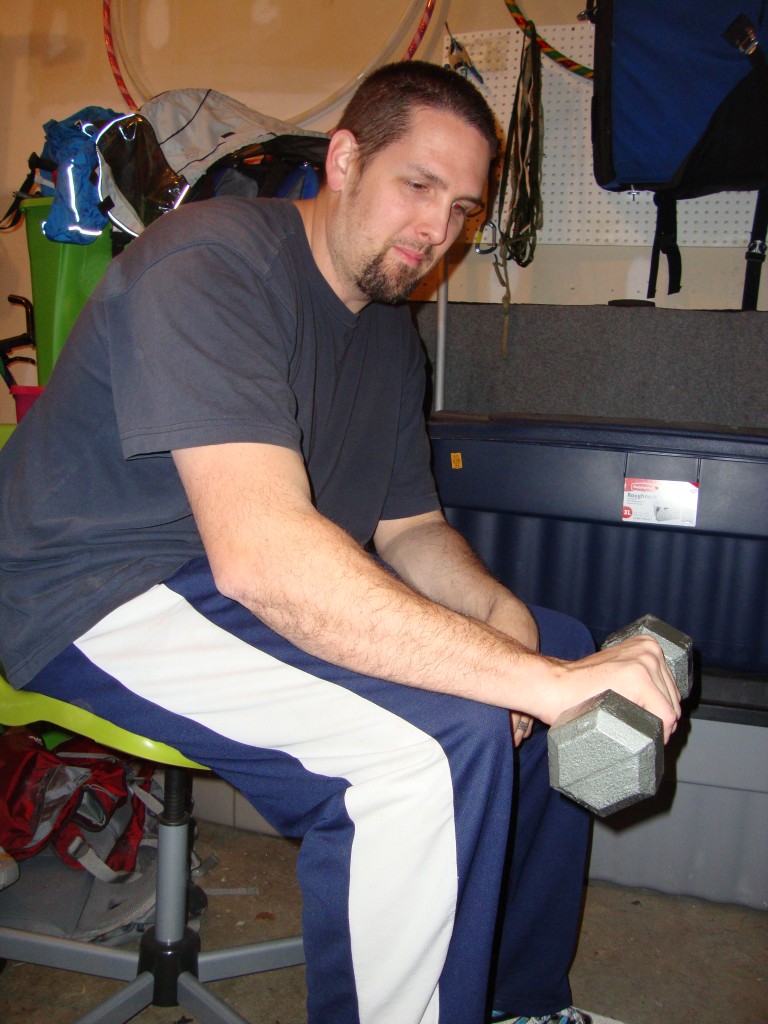

18 Responses to “Extracurricular Training Part 1 – The Antagonists”
Great article Erica! I admit.. I tend to slack off in the area of push-ups, etc. Kayaking has been a great way to cross-train and strengthens some of my push muscles with the pushing/pulling of each stroke of the paddle. But — I’m gonna try adding the pushups on the BOSU ball to my routine! Thanks for the well-written advice! 😀
April – Glad you enjoyed the article. In a perfect world we could be completely balanced by the right amount of cross training and not have to step in the weight room…
Good article Erica. I think most climbers slack off when it comes to antagonist training. Big mistake in my opinion. Doing these exercises is like eating your broccoli. It will ensure your durability and reduce chances of injury. Doing these will not directly make you a better climber (which many people get hung up on) but it will make sure you don’t have to take months off because you blew your shoulders out.
If I may, let me suggest a couple of things. Focus on compound movements. Those tricep kickbacks are a waste of your time, similar to doing bicep curls. Focus on your bench press/push ups, shoulder presses, and dips. Dips should be tertiary because the bench press and shoulder press are more of a direct antagonist to pull ups. Also, once your foot gets better, you can do full body exercises such as thrusters to hit the push legs and push arms.
Also, (excuse me if I sound like I’m on a soap box) the biggest myth in training is that you will gain weight by lifting heavy weight. You should lift heavy weight! Focus on 5 x 5 instead of 2 or 3 x 10 or 12. When we do pull ups we lift heavy weight so we shouldn’t slack off on the push as well. Actually, you will gain an Arnold physique by doing a 3 x 10 style of workout. You will not gain weight by doing 5 x 5 or something close to that. Olympic lifters deadlift over 500 lbs at a body weight of 170. Unfortunately, many ladies don’t want to “lift like men” because they are afraid they will get big. You don’t have the testosterone to get big. It just won’t happen. Don’t be afraid to hit the weights hard! 🙂
Gif – Agreed that compound movements are best, although I wouldn’t go so far as to say the kickbacks are a waste of time. The movement is more isolated, but works one arm at a time, which in some ways could be argued that it is more climbing specific. Not a fan of the bench – I think I get a way better workout on the rings because of all the extra stabilizing muscles that get worked as well.
As far as your soapbox goes – I completely agree with your logic that women don’t have the testosterone to get big like a bodybuilder if they hit the weights hard. I was a personal trainer for several years and spent a good bit of time convincing my female clients they could still lose the weight they wanted while pushing themselves with the weight. However, when it comes to antagonist training I don’t think its necessary to pile on so much weight as to produce failure after only 5 reps. I guess I prescribe to the mentality that as long as you go to failure/exhaustion, you don’t have to push around super heavy weights. I think I’ve seen Eric Horst actually recommend no more than 20 – 40% of body weight for antagonist training. I think the mistake women make many times is not the fact that they do 10-12 reps, but the fact that they do 10-12 reps at a weight that only partially fatigues them rather than pushing themselves to exhaustion.
Just like there are multiple ways to do a crux sequence, the beauty of training is that there are many theories, each with their own merit. Thanks for the discussion Gif. Looking forward to maybe crossing paths at the New this spring once my foot heals! 🙂
I actually disagree with Horst on his antagonist training. I’m much more in line with Steve Bechtel, who prescribes heavy weight. The lighter weights 3 x 10 stuff will promote mass gain (hypertrophy) where the heavy 5 x5’s promote strength without the mass. Also it promotes better connective tissue health among other things.
We definitely need to cross paths at the New! Let’s plan on it. Heal fast! 🙂
Fantastic insight! I used to do 30 morning pushups, triceps kickbacks and overhead shoulder presses before I started climbing mid Nov… haven’t done a single one since. 🙁 by your logic I’ll be adding reverse wrist curls. Thanks!!
Love this post. Push ups are normal routine in my martial arts training as are tricep and shoulder work, but I only recently started working on wrists as I’ve been battling an elbow issue for several months after a whole lot of climbing! Stretching the forearm religiously and adding in the the reverse wrist curls the last month have me back to close to 100%.
Hi I am a mountaineer and climber. I have just been recently having trouble with my feet.. never in my life have I had issues while climbing or treking. I just got diagnosed with leg length discrepency.. apparently my left leg is slightly shorter. Found out that is caused by Scoliosis that I just got diagnosed with. I was told I was born with it and that it is slight curvage that I never felt it as a kid but I did walk and stand a lil differnt but noone really noticed that much. Now that I am almost 40.. I am feeling it more. My dr said my Tendons in my foot are an issue that I need to wear insoles.. I just did a hike with insoles. ouch from hell! I am researching on how to strengthen the inside muscles of your entire foot.. many people say that being barefoot every chance you get helps to toughen them up and then to wear the protective shoes for hikes. But to always wear the protective shoes we have now they are babying our muscles to weakening. I am not sure but trying to find the best way to make my foot muscles stronger. Any ideas? I need excercises that focus on feet.
Thanks for the great tips! I recently injured my shoulder and as a newer climber I had greatly underestimated the need for training. I thought that doing mostly climbing would build the strength that I needed. Now that I’m on the sidelines for a few weeks, I have been enlightened to the need of overall training, especially to prevent injury. Looking forward to the next post.
Thank you for this post. The way you explained it allowed me to make sense of it all. Now I need to get my but in gear and focus on balancing my push/pull muscles.
Benjamin Eaton
eatonpitches.blogspot.com
If your joints can handle it (and only if), hard shoulder work is very good for bullet-proofing your elbows, delts, and rotator cuffs. The gymnast rings work well for this because they mimic climbing movements much better than fixed plane movements, as they recruit the often underused ancillaries to a much higher degree. Gradually work up to flyes and dips and you’ll be gastoning like a a madman (or woman) in no time. I personally have seen big gains in my ability to make difficult lock off moves with control (static) since strengthening my shoulders. Highly recommended.
Jessica – Hope your shoulder gets better soon and that you can work towards hopefully preventing an injury from happening again!
Benjamin – Thanks for the kind words, glad you enjoyed the post!
Were these photos taken at inner peaks NC?
Preston – Yup, IP is our home gym. 🙂
Extracurricular Training Part 1 – The Antagonists | Cragmama
I miss doing my Triceps Kickbacks and Push-ups. I stopped going to the gym for a month now based on doctor’s advice.
Whats up this is somewhat of off topic but I was wondering if blogs
use WYSIWYG editors or if you have to manually code with
HTML. I’m starting a blog soon but have no coding skills so I wanted
to get advice from someone with experience. Any help would be greatly appreciated!
Feel free to surf to my blog post how to improve memory
Has anyone seen a scientific study – even a small or pilot – testing whether antagonist training actually reduces injury risk in climbers or any comparable pull-intensive sport (gymnasts, rowing, etc)?
There are lots of good reasons to train extension patterns. I do. But it’s difficult to see how the stabilizing functions of muscle groups are better trained for that function by any stressor other than the precise one where their stabilizing is desired. Or that medial epicondylitis, rotator cuff strains, etc., are attributable to an absence of “balance” (whatever that may mean, however that might be measured). Great bench pressers get elbow issues all the time from pull-ups – despite having “antagonist” strength that few if any climbers will ever approach. Or that a push-up or dip inoculates the rotator cuff group against the strain of a ballistic move on steep terrain – they are hardly mirror opposites. Or that the risk of soft tissue injury associated with the antagonist exercises themselves still nets to an improvement. Or that 30 reps of an antagonist exercise in any way “balances” the hundreds of reps of pulling on each arm in a single gym session.
Is there more than anecdote and current lore behind it? I’d love to know. Though I’ll keep doing push-ups and dips and more, regardless – because it’s just good to be strong for general purposes in life.